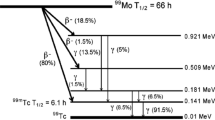Abstract
Scintillator silica fine powder pellets showed photoluminescence and mechanoluminescence. The mechanoluminescence intensity decreased by about 90% in approximately 30 min at room temperature. The photoluminescence intensity increased and remained constant after 5 min when UV light was irradiated onto the pellets. This suggested shallow traps in the energy structure of the scintillator silica fine powders. The counting efficiency of 0.8 ± 0.2 Bq of tritium was enhanced from 27 to 212 times when the shallow traps were excited by the dropwise addition of 2687 ± 11 Bq of tritium or UV light irradiation on the same surface of the pellets.











Similar content being viewed by others
References
Birks JB (1964) Organic plastic scintillators (chapter 9). In: Birks JB (ed) The theory and practice of scintillation counting. Pergamon Press, Oxford
Furuta E, Kawano T (2015) A plastic scintillation counter prototype. Appl Radiat Isot 104:175–180
Tribollet E, Dreifuss JJ, Charpak G, Dominik W (1991) Localization and quantitation of tritiated compounds in tissue sections with a gaseous detector of β particles: comparison with film autoradiography. Proc Natl Acad Sci USA 88:1466–1468
Birks JB (1964) Organic crystal scintillators (chapter 7). In: Birks JB (ed) The theory and practice of scintillation counting. Pergamon Press, Oxford
Yang W, Lee EKC (1969) Liquid scintillation counting, singlet-singlet energy transfer processes. J Chem Educ 46(5):277–283
Miyoshi H, Ikeda T (2013) Preparation of paper scintillator for detecting 3H contaminant. Radiat Prot Dosim 156(3):277–282
Miyoshi H, Hiroura M, Tsujimoto K, Irikura N, Otani T, Shinohara Y (2016) Preparation of new scintillation imaging material composed of scintillator-silica fine powders and its imaging of tritium. Radiat Prot Dosim (in press)
Schatz T, Cook AR, Meisel D (1998) Charge carrier transfer across the silica nanoparticle/water interface. J Phys Chem B 102(37):7225–7230
Imhof A, Megens M, Engelberts JJ, Lang DTN, Sprik R, Vos WL (1999) Spectroscopy of fluorescein (FITC) dyed colloidal silica spheres. J Phys Chem B 103:1408–1415
Lakowicz JR (2010) Principles of fluorescence spectroscopy, 3rd edn. Springer, New York
Birks JB (1964) The theory and practice of scintillation counting. Pergamon Press, Oxford
Megelski S, Lieb A, Pauchard M, Drechsler A, Glaus S, Debus C, Meixer AJ, Calzaferri G (2001) Orientation of fluorescence dyes in the nano channels of zeolite L. J Phys Chem B 105:25–35
Browne E, Firestone RB (1986) Table of radioactive isotopes. Wiley, New York
Peng D, Chen B, Wang F (2015) Recent advances in doped mechanoluminescent phosphors. ChemPlusChem 80(8):1209–1215
Tiwari G, Brahne N, Sharma R, Bisen DP, Sao SK, Sahu IP (2016) Ca2Al2SiO7: Ce3+ phosphors for mechanoluminescence dosimetry. Luminescence 31(8):1479–1487
Acknowledgements
The TEM observations were performed by Mr. Ueki at Tokushima University, and the measurements of the fluorescence lifetime were performed by Hamamatsu Photonics Inc., to whom we are sincerely grateful. This work was supported by the Japan Science and Technology Agency (JST) under the Matching Planner Program through Grant Number MP27115658836.
Author information
Authors and Affiliations
Corresponding author
Rights and permissions
About this article
Cite this article
Miyoshi, H., Gotoh, H., Hiroura, M. et al. Enhancement of counting efficiency for tritium using light-excited scintillator silica pellets. J Radioanal Nucl Chem 311, 1991–1999 (2017). https://doi.org/10.1007/s10967-017-5185-2
Received:
Published:
Issue Date:
DOI: https://doi.org/10.1007/s10967-017-5185-2




